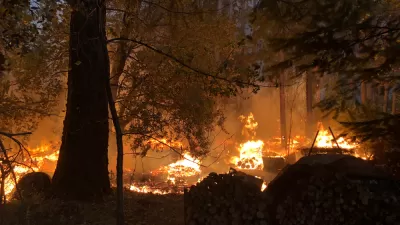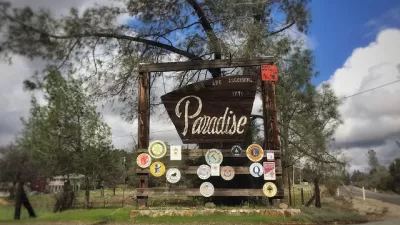The California community lost 85 lives and tens of thousands of homes. Now, high housing and rebuilding costs are forcing many former residents out.

Five and a half years ago, the town of Paradise, California burned in a devastating wildfire that killed 85 people. Today, many former residents are finding it hard to go home, displaced by deeper-pocketed transplants, wrrites Sam Mauhay-Moore in SF Gate.
“For three years in a row, data from California’s Department of Finance marks Paradise as the fastest-growing town in California. The town grew by 16.1% in 2023 (for reference, Lathrop, the state’s second-fastest-growing town, grew by only 5.4%).” And while that growth only represents 1,500 people, the change is dramatic for the small community.
“[Real estate broker Warren Bullock] puts the median price of a home in Paradise at about $450,000, a stark difference from the state’s median home price of over $900,000. But those prices are still too high for many pre-fire residents to afford, and the cost of rebuilding what they lost is also often out of reach.”
Local ordinances prohibit living in tiny houses or motor homes on residential lots, eliminating affordable housing options. Meanwhile, home insurance rates skyrocketed after the fire, a problem common across the state.
For its part, Paradise is on the road to recovery, repaving roads, undergrounding power lines, and building a new sewer line. The Camp Fire Restoration Project is using permaculture principles to restore the land in the area and make it more resilient through tree giveaways, composting workshops, soil health projects, and other efforts.
FULL STORY: In a California town destroyed by wildfire, locals are priced out by city transplants

Alabama: Trump Terminates Settlements for Black Communities Harmed By Raw Sewage
Trump deemed the landmark civil rights agreement “illegal DEI and environmental justice policy.”

Planetizen Federal Action Tracker
A weekly monitor of how Trump’s orders and actions are impacting planners and planning in America.

The 120 Year Old Tiny Home Villages That Sheltered San Francisco’s Earthquake Refugees
More than a century ago, San Francisco mobilized to house thousands of residents displaced by the 1906 earthquake. Could their strategy offer a model for the present?

In Both Crashes and Crime, Public Transportation is Far Safer than Driving
Contrary to popular assumptions, public transportation has far lower crash and crime rates than automobile travel. For safer communities, improve and encourage transit travel.

Report: Zoning Reforms Should Complement Nashville’s Ambitious Transit Plan
Without reform, restrictive zoning codes will limit the impact of the city’s planned transit expansion and could exclude some of the residents who depend on transit the most.

Judge Orders Release of Frozen IRA, IIJA Funding
The decision is a victory for environmental groups who charged that freezing funds for critical infrastructure and disaster response programs caused “real and irreparable harm” to communities.
Urban Design for Planners 1: Software Tools
This six-course series explores essential urban design concepts using open source software and equips planners with the tools they need to participate fully in the urban design process.
Planning for Universal Design
Learn the tools for implementing Universal Design in planning regulations.
Clanton & Associates, Inc.
Jessamine County Fiscal Court
Institute for Housing and Urban Development Studies (IHS)
City of Grandview
Harvard GSD Executive Education
Toledo-Lucas County Plan Commissions
Salt Lake City
NYU Wagner Graduate School of Public Service





























